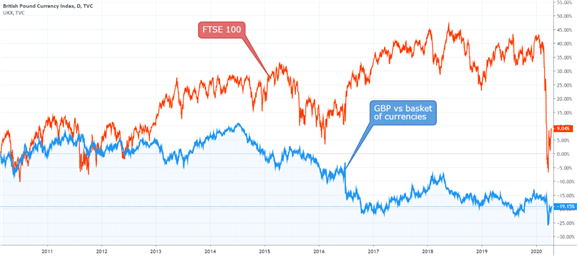The FTSE 100 represents the 100 largest companies listed on the London Stock Exchange by market capitalization, while the FTSE 250 lists the following 250 companies (From 101st to 350th). But what other key differences between the two indices can influence trading decisions? Read on for the full FTSE 100 vs FTSE 250 comparison.
FTSE 100 vs FTSE 250: Summary of differences
There are a number of key differences to be aware of when looking at the FTSE 100 vs FTSE 250. These include global footprint, the influence of certain industries on the price of the indices, and how to interpret fluctuations – as well as factors more specifically related to trading these assets, such as volatility and liquidity levels.
| Key Differences Between FTSE 100 and FTSE 250 | ||
|---|---|---|
| FTSE 100 | FTSE 250 | |
| Established | 1984 | 1992 |
| Composition | Largest 100 UK companies by market capitalization | 101st-350th largest UK companies by market capitalization |
| Market capitalization (April 9, 2020) | £1.63 trillion | £179 billion |
| All-time closing high | 7,868 (May 2018) | 22,097 (Jan 2020) |
| Industry focus | Heavy focus on mining, oil, finance, pharmaceuticals | Broader industry focus |
| Revenue source | Largely overseas | Around half domestic, half overseas |
| Volatility | Usually less volatile | Usually more volatile |
Market Cap
The biggest difference between the FTSE 100 and the FTSE 250 is market capitalization. Naturally, given the size of the companies in each index, the capitalization of the FTSE 100 is considerably larger than the FTSE 250, and the market cap of the top few companies has a disproportionate impact on the wider index. Meanwhile, the FTSE 250 has a smaller market cap with price movements influenced by a wider range of companies – as explained further in the next point.
Industry Focus and Weighting
The FTSE 100 is focused heavily on blue-chip or large cap stocks in select sectors, such as Shell and BP in oil, GlaxoSmithKline and AstraZeneca in pharmaceuticals, BHP Billiton and Rio Tinto in mining, and HSBC and Barclays in banking. These are the companies that have the greater weighting in the index; for example, HSBC’s weighting is 9.22% and Shell’s 8.39%, as of this writing. This means any fluctuations in the price of these larger constituent stocks is more likely to impact the wider index than stocks with a company with a smaller weighting.
Meanwhile, the FTSE 250 has a broader range of industries and a flatter weighting, with a more proportional representation for sectors like consumer services and industrials than the FTSE 100.
For more on weightings and how the FTSE 100 is calculated, see our What is the FTSE 100? piece.
Revenue Source
Around 70% of revenue for the FTSE 100 comes from international sources. This fact is important because it has strong implications for the influence of the Pound’s value on the index. Since such a large proportion of revenue for FTSE 100 companies is made in USD, a weakening British Pound means that revenue is worth more when converted back to GBP. This factor often overcomes the other side of the coin – that imports become more expensive when GBP weakens. Consequently, as Sterling falls, the FTSE 100 has often risen historically.
The below chart from TradingView shows that while there are some periods of alignment, instances such as the 2016 EU referendum, which sunk the Pound and bolstered the FTSE 100, can drive an inverse trend.

However, since the FTSE 250 has more of a domestic focus, there is less of a pronounced history of GBP fluctuations affecting the index than with the FTSE 100, although history suggests the mid-cap index may tend to benefit from stronger Sterling.
FTSE 100 returns vs FTSE 250 returns
Returns for the FTSE 250 have been seen to be higher, percentage-wise, than for the FTSE 100 for large periods of their history. From Jan 1, 2015 to Jan 1, 2020, the price of the FTSE 250 rose 37% compared to the FTSE 100’s 16% over the same period, as can be seen in the chart from TradingView below.

It stands to reason that smaller mid-cap stocks may have higher growth potential than large blue-chip issues, meaning the FTSE 250 may perform proportionally better than the FTSE 100 during 'risk on' periods in the market. Conversely, during periods of more bearish sentiment, money may flow into larger, more defensive stocks which may be seen as carrying a smaller degree of risk overall given their sheer size and capital resources.
However, it’s important to be wary of the fundamental events that cause market crashes as sectors can be hit differently depending on the nature of the shock. In the case of the coronavirus outbreak in 2020, there were few attractive UK stocks due to the subdued global demand for oil, low interest rates hitting banking stocks and the general slump in economic activity dragging many other sectors down.
Trading the FTSE 100
The FTSE 100 is a popular index to trade with high liquidity and lower spreads. It gives an opportunity to trade from 8:00 GMT to 16:30 GMT when the London Stock Exchange is open, with global speculators, where permitted, using futures, ETFs or other vehicles to go long or short on the index’s price. Many strategies may be viable when trading this index, from short-term day trading to longer-term position trading. Check out our article on how to trade FTSE 100 for more.
Trading the FTSE 250
When it comes to the FTSE 250, traders should be aware that, unlike the FTSE 100, the FTSE 250 is not the most popular index in the UK and may see periods of low liquidity, meaning a tendency for wider spreads. For this reason, it tends not to be used by day traders often.
However, with smaller companies often having more capacity to grow, longer-term trend trading has seen notable periods of the mid-cap index outperforming the FTSE 100, as mentioned earlier. The FTSE 250 has also offered periods of higher volatility than the FTSE 100, so while there may be opportunities available, there is also potential for greater risk.





